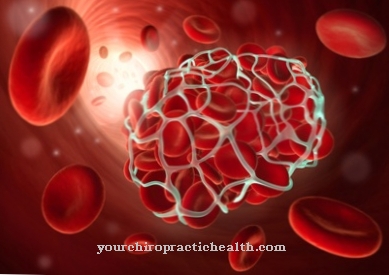The embryonic liver development is a multi-stage process in which, in addition to the liver, the biliary tract and gallbladder are formed. The epithelial bud serves as an exit and undergoes a proliferation up to the functional organ. Embryonic development disorders can occur during liver development.
What is Embryonic Liver Development?

In embryogenesis, the individual tissues of the later individual develop from omnipotent cells to their final morphology. Part of this development is embryonic liver development. This multi-stage process corresponds to the formation of the liver and the hepatobiliary system. The biliary tract and gall bladder are thus included in the development.
The liver is the central organ of metabolism. Their starting material is the epithelial bud, which gradually proliferates until it becomes a fully functional organ. The embryonic development of the overall hepatobiliary system can be divided into two steps. First, the parenchyma of the liver, biliary tract and gallbladder develop. The second step is the development of the intrahepatic vessels. The development of the vascular system helps the components to achieve their final function.
Function & task
At the beginning, endoderm cells sprout in the duodenum area of the embryonic liver development. In the embryonic stage with seven somites, the liver primordium, known as the hepatopancreatic ring, is created in this way and comprises two different sections. The lower section is created by constrictions and serves as the original material of the gallbladder, the cystic duct and some parts of the bile duct. In addition to the liver parenchyma, the other biliary tracts develop from the upper section. The cells for the formation of the liver parenchyma grow into the ventral mesogastrium and also infiltrate the transverse septum for the attachment of the diaphragm. After this step, the panels and beams are rearranged. The blood-filled sinus wraps around the structures like a seam. Sinus endothelial cells form its walls and originate from the transverse septum.
Blood formation in the embryonic liver reaches its climax in the seventh month of pregnancy and drops to zero by the time of birth. The intrahepatic vascular system forms in the second step of the embryonic liver development. The yolk veins take their course within the immediate vicinity of the intestinal tube. They form anastomoses both in front of and behind. After the remodeling processes initiated, the vitelline veins and their anastomoses give rise to the hepatic veins that lead to and from them and the intrahepatic blood sinus.
The liver parenchyma grows around the yolk veins and their anastomoses and gives the resulting sinusoid connection to the venous system. The cranial vascular network becomes the intrahepatic part of the inferior vena cava and the efferent vein. The latter veins become the hepatic veins. This is followed by obliteration of the left vitelline vein, which creates a uniformly feeding vein trunk. Later on, the vein trunk becomes a source of the vena portae hepatis. Connective tissue made of mesenchyme lies along the vena portae hepatis, which is involved in a proliferation process from the seventh week of development and thus spreads along intrahepatic branches. Parts of the hepatic artery grow into the resulting layer of connective tissue and branch out into septa.
With the portal of the liver as the starting point, the process continues into the interior of the liver. The blood-carrying umbilical veins are located to the left and right of the liver anlage. Your blood comes from the placenta. The umbilical vein on the left is later connected to the sinus system. The right umbilical artery recedes. The arterialized placental blood is then transferred to the liver. This is followed by remodeling work on the intrahepatic vascular system so that the blood can be conducted directly via the hepatic efferent veins and through the vena cava into the heart.
Illnesses & ailments
Various disorders, also known as embryonic development disorders, can occur during embryonic development. Some of these are caused by internal factors, which are usually genetic mutations or hereditary factors. Other developmental disorders are due to external factors and may be related, for example, to poison exposure or malnutrition of the mother during pregnancy. For example, cysts of the organ in connection with the liver can be attributed to such a developmental disorder. For example, cystic liver degeneration is a consequence of embryonically disturbed biliary tract development. In most cases this phenomenon is associated with cystic degeneration of the kidneys and manifests itself in the newborn as a greatly enlarged liver.
A disturbance in the development of the embryonic liver is also the cause of the so-called Von-Meyenburg complex. The main symptom of this disease is a hamartoma of the liver with enlarged structures of the bile ducts and parts of connective tissue. The Von Meyenburg complex arises from an embryonic malformation on the ductal plate. This formation of tissue is the starting point for the development of each bile duct in the liver. This disease is also associated with cystic changes in the liver and kidneys. Apart from the cysts, the complex consists mainly of macroscopically visible gray-white foci, usually no more than one centimeter in size, which appear either individually or in groups. Often these foci are just below the capsule of the liver. A tissue analysis reveals groups of moderately enlarged ducts of the bile. As a rule, there are no atypias. The changes are embedded in connective tissue. In individual cases they contain bile.



























